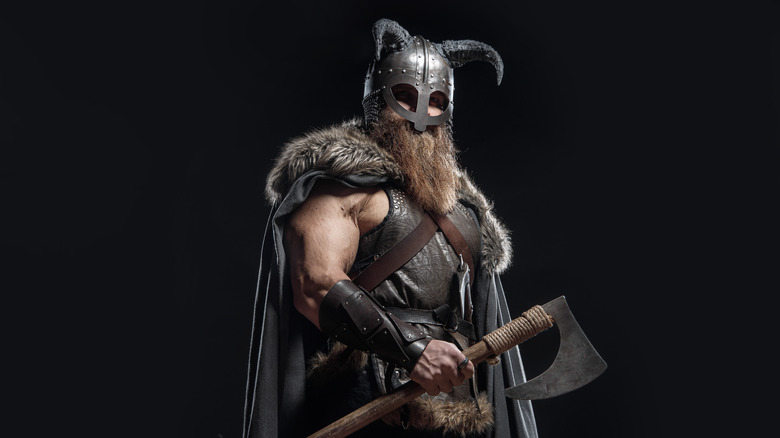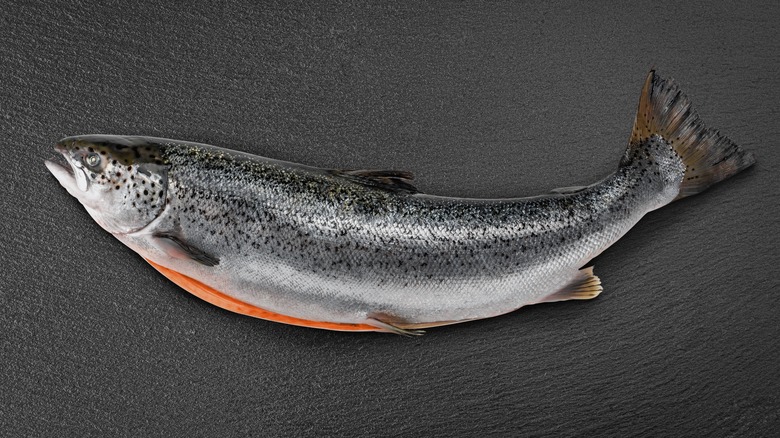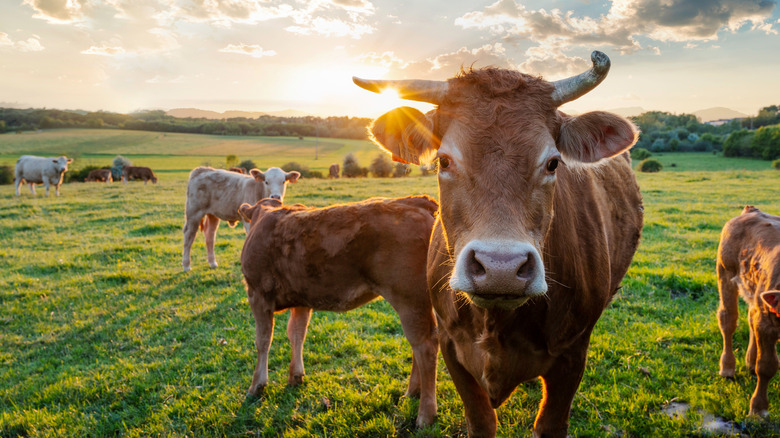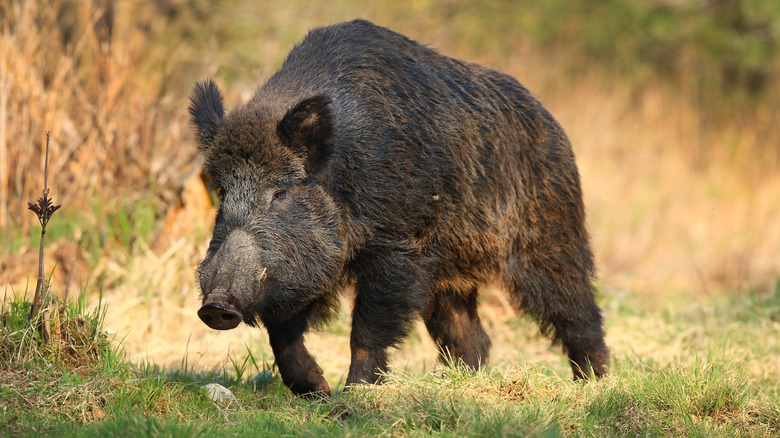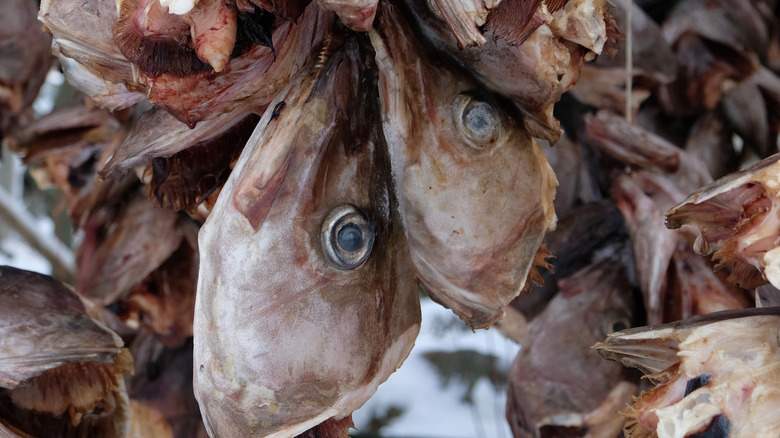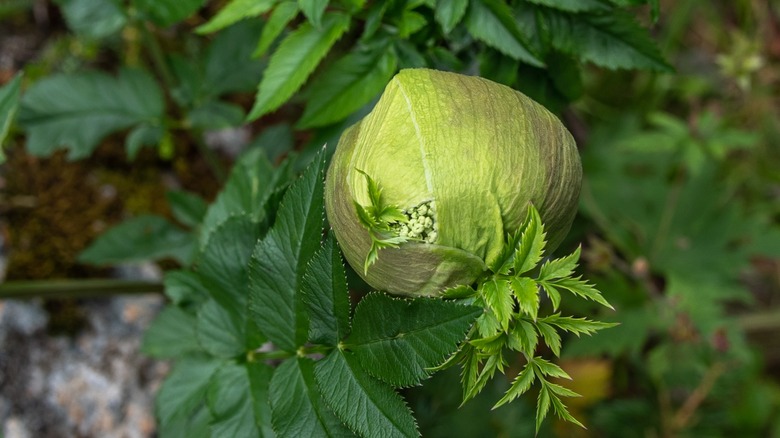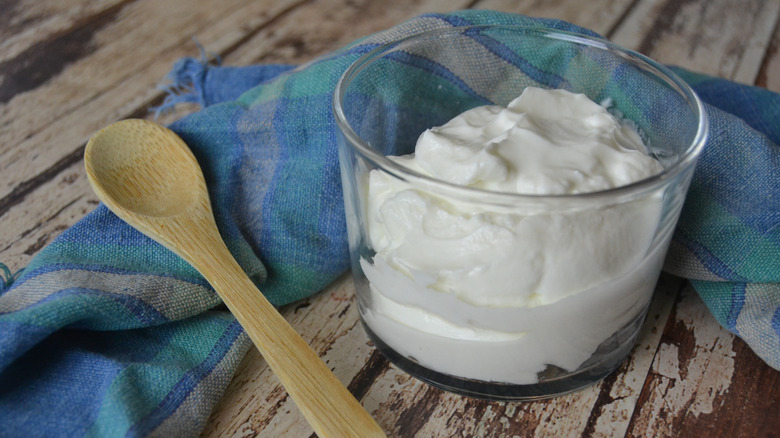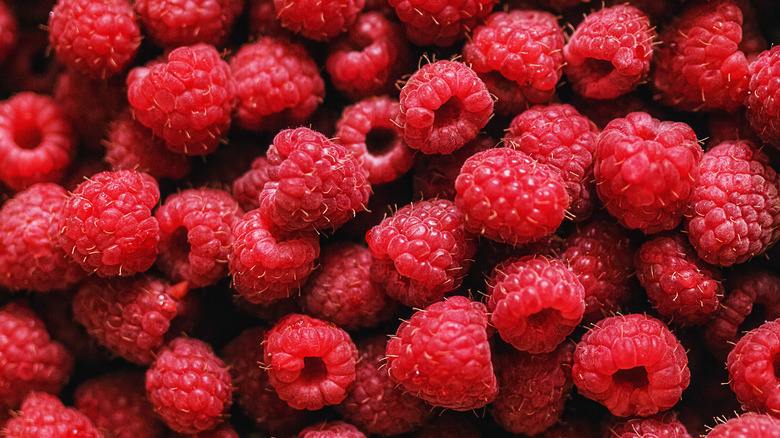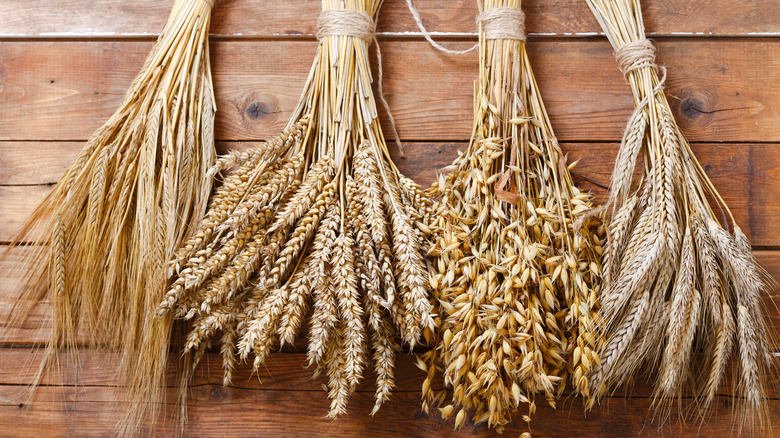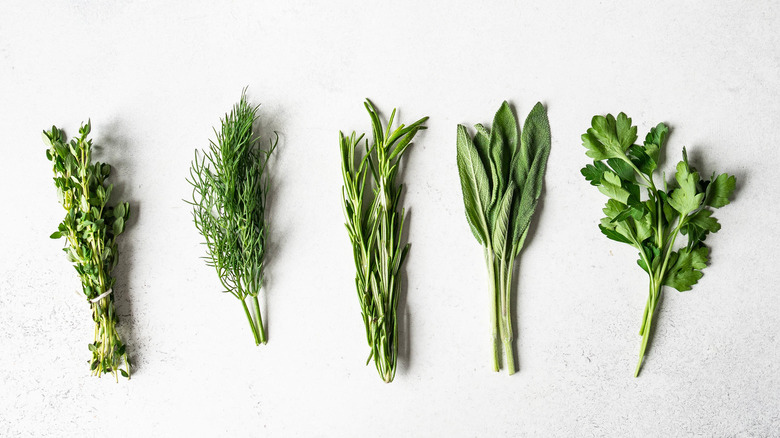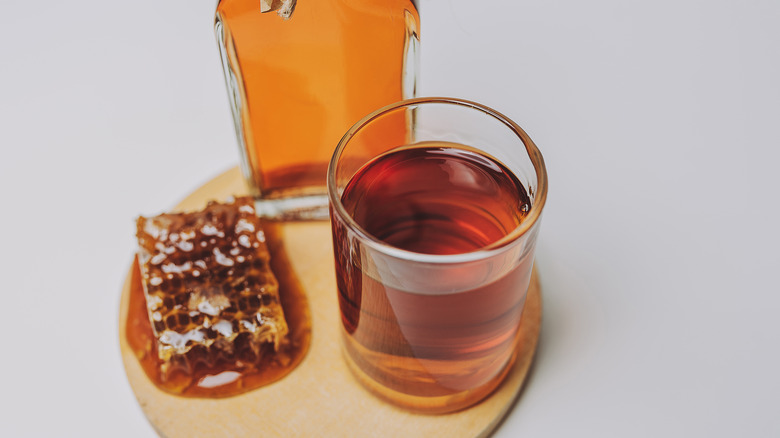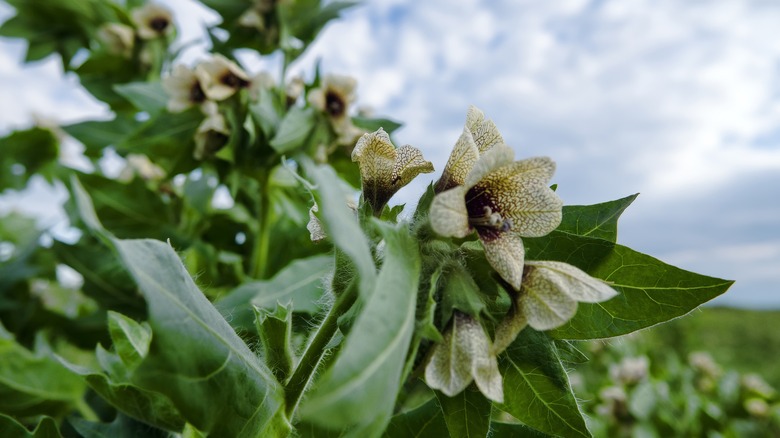What Did The Vikings Really Eat?
The Vikings are often depicted as brutes, little more than barbarians who raided and plundered peaceful settlements throughout northern Europe. While they did colonize regions of Europe between the 9th and the 11th century, according to Britannica, there's much more to these Scandinavian warriors than meets the eye. Hailing from modern-day Norway, Denmark, and Sweden, the Vikings built a sophisticated Norse culture that included far more than warriors. Many of them were anything but bloodthirsty killers, such as farmers, fishermen, and traders who roved far afield to make a profit (via History Extra).
For much of their history, the Vikings weren't an especially literary culture and so didn't write down their recipes. The earliest Scandinavian cookbook was only first compiled between 1300 and 1350, as per the Viking Answer Lady. Instead, they passed their culinary know-how down by word of mouth. It would have varied considerably from region to region since Norsemen established settlements in places as far from home as Greenland and Russia. According to the Jorvik Viking Center, this naturally meant that the Viking diet would have varied depending on where those Vikings had settled.
Despite the sometimes forbidding landscapes of their settlements, the Vikings generally ate a balanced diet, with both the elite and common folk consuming meat daily. And while the Viking diet wasn't overly inventive, it's said that the Norsemen ate much better than their contemporaries in other cultures (via History). Here's what the Vikings really ate.
Food from the water
Since most Viking people lived along the coast or rivers, it shouldn't come as a surprise that a large portion of their diet consisted of seafaring fish such as herring (via Life in Norway). Fish made up around 25% of the calories of the diet of Norwegian Vikings who lived near the sea, the Viking Answer Lady notes, making it clear that this was a vital food resource for the Norse. That means we need to adjust our image of longboats packed with Vikings, too. While we usually picture the Vikings sailing across the seas, the everyday reality of their lives was far less glamorous. Most Norse families owned dug-out canoe-style boats, which they took out for their fishing expeditions, according to "Children of Ash and Elm: A History of the Vikings" (via Sons of Vikings).
According to Sons of Vikings, the Vikings utilized different fishing techniques depending on the size of the catch. It's believed that they used a line to catch large fish such as salmon or nets for smaller fish like herring. The Vikings also ate marine mammals including whales, though they would have avoided actively hunting the large animals and instead scavenged off beached whales. Evidence also suggests that Vikings in remote Iceland, Greenland, and northern Scandinavia consumed seals and walruses.
Domestic livestock
From magnates to sailors and the common folk, cattle were often the most important livestock for the Vikings. To that end, cattle remains have been found in large piles near Viking settlements in Scandinavia. These were found alongside traces of goat, sheep, and pig bones (via Sciencenorway). Viking communities also raised geese, chickens, and ducks for their meat and eggs. Generally, animals were only slaughtered as cold weather approached, maximizing their yield for the harsh winters ahead and conserving feed for the remaining animals, according to the Viking Answer Lady.
The Vikings also ate horse meat, although it was probably only consumed at festivals rather than as an everyday staple, as per Sciencenorway. Horse bones are scant around Viking settlements; instead, they have been discovered in wetlands, a hint that they may have been a part of ritual feasts. In the Christian Middle Ages, the consumption of horse meat became associated with pagan sacrifice.
While the Vikings did grill their meat on roasting spits, they preferred to boil it in stews. The meat and vegetables were usually cooked in large clay or iron pots. Eating was a community affair, with the stews sometimes boiling over open flames for days (via Vikings Brand).
Wild animals
While the Vikings did hunt, game made up a relatively small part of their overall meat consumption. Nevertheless, in some remote northern areas such as Norrland in Sweden and Nordland in Norway, raising domestic animals was difficult and slaughtering them was a serious proposition. So, remote Norse communities tended to rely far more on wild meat (via Viking Answer Lady). Vikings residing in settlements far afield, such as Iceland, found that animals there were trickier to hunt due to harsh weather conditions and low populations. So, they consumed wild animals as a dietary supplement rather than a staple (via Sons of Vikings).
When they could, the Vikings usually hunted elk, deer, and reindeer. While not as common, they also kept their eye out for boars and bears. Squirrels were also probably used for their meat, though the rodents were more prized for their fur. Indeed, Vikings didn't just hunt for meat; they went into the forests to obtain raw materials such as hides, antlers, and sinew. Historians have said that hunting certain larger animals such as bears was the prerogative of those of high status with set rules about who could hunt in what areas (via Sciencenorway). When hunting, the Vikings usually used bows and arrows or animal traps. They also sometimes tamed falcons and used them to hunt for other birds.
Preserved food
While fresh food was abundant in many Viking settlements during the summer and fall, this wasn't the case for winter and spring. Many Norse found themselves in harsh environments with exceedingly cold winters, meaning that a mid-December salad was simply out of the question. As such, it was imperative to preserve foods for consumption during those harsh months. It's clear that the Vikings did something right here since modern research shows that they were rarely deficient in any vitamins or minerals (via History on the Net).
The Vikings usually slaughtered many of their sheep and cattle in October and pigs in November or December. This ensured that they didn't have to feed them during winter. They preserved the meat by salting, smoking, drying, fermenting, or pickling it in sour whey, depending on the region. In northern Scandinavia, freezing was also common, as Viking Answer Lady notes.
While salting was a great way of preserving food, the mineral was relatively expensive, since it had to be imported, according to Vikings Brand. This meant that many families resorted to drying or smoking their meat and fish. Archaeologists have discovered smokehouses and storage sheds that date back to the Viking Age (via Sons of Vikings). The Vikings also often fermented food in underground pits. Fermentation is still used in some Scandinavian dishes, including the famously pungent hakarl (fermented shark) sometimes consumed in modern Iceland, according to Atlas Obscura.
Vegetables
While it's easy to picture the Vikings as carnivores, the truth is that they consumed a lot of plants. While they may not have eaten some of the vegetables that we enjoy today such as the supermarket staples of tomatoes, cucumbers, and potatoes, we know that they commonly consumed plenty of other options. These included onion and Norwegian angelica, a plant that's also known as wild celery. In fact, Norway's oldest laws, which were first put into practice sometime between 1000 and 1200 CE, mention both of these vegetables and emphasize their importance, stating that raiding a veggie patch makes one lawless (via Sciencenorway).
Depending on the region, other vegetables cultivated by Viking farmers included cabbage, peas, beans, and endive. They also ate root vegetables such as beetroot, which could be left underground during the winter months, simplifying storage and consumption in an otherwise intense time for food preparation (via Life in Norway).
If the conditions got dire enough, Norsemen sometimes turned to wild forage like acorns and sandwort, although both were treated as emergency food, according to the Viking Answer Lady. A lot of the veggies grown at the time were wild varieties that would look and sometimes taste pretty different compared to the modern types we might consume today. For example, Viking carrots were white and not the bright orange we find at many modern supermarkets, as History notes.
Dairy products
Cattle, goats, and sheep weren't just sources of meat for the Norse. All of these animals were also used to produce milk during the Viking Age. Indeed, most cows weren't slaughtered for meat until they had produced and fed a calf, with some milk cows kept alive for up to a decade, as History on the Net notes. While most Vikings enjoyed drinking milk, the product was usually processed further to make other, longer-lasting foods that could be consumed during winter.
Some of the dairy foods that were a hit with the Vikings included butter, buttermilk, cheese, and curds. Salt was usually added to cheese and butter to preserve them. Whey, which is the sour liquid that separates from the curds during the cheese-making process, was also used to help keep butter palatable for a long time, according to the Viking Answer Lady.
The Vikings also processed milk into skyr, a type of soft and mild-flavored yogurt that's still eaten by Icelandic people today (via Life in Norway). High in protein and low in sugar and fat, skyr is often seen as a healthy food in Scandinavia today, where it's often eaten for breakfast or as a snack (via Arla Foods). While skyr has a consistency similar to Greek yogurt, it has a thicker and creamier texture thanks to the unique Icelandic cultures and the amount of milk used to make it. Producing one cup of skyr requires around four cups of milk, according to Eating Well.
Fruit, berries, and nuts
Many Viking farms across Scandinavia and the settlements included orchards meant for growing fruit such as apples, plums, cherries, and pears. While the Norse certainly would have enjoyed fresh fruit during the warmer months, they also dried them for winter (via Life in Norway). In addition to cultivated crops, many Vikings took some time to forage for wild berries, such as strawberries, raspberries, elderberries, hawthorn, bilberries, and rowan. The Icelandic word for bilberry is bláber, which translates to "blue berry." As such, when it comes to the Viking diet, many sources erroneously refer to bilberries as blueberries, as per the Viking Answer Lady. However, bilberries, while literally blue in color, are distinct from the carton of blueberries you might snack on nowadays.
The Vikings also enjoyed nuts. However, the only nuts that were available near many of their settlements would have been hazelnuts. While the far-traveling Norse eventually had access to walnuts, chestnuts, and almonds, those typically had to be imported from abroad, according to Ancient Origins. When they could get them, the Vikings commonly added those nuts to porridge and the yogurt-like skyr. Both dishes were also sometimes flavored with berries (via Vikings Brand).
Grains and bread
Since a lot of Viking settlements were inhospitable to crops for a significant portion of the year, Norse people generally didn't cultivate wheat. Growing the crop was only possible in some parts of Denmark. Instead, Vikings in other places usually focused on cultivating hardier grains such as barley, oats, and rye. Rather than grinding the grains into flour, like we do today, the Vikings more often boiled them until they were soft and could be swallowed more or less whole. The result wasn't always a hit at the dinner table. In the 13th-century Icelandic "Tale of Sarcastic Halli," the Vikings of Harald Hardrada's court express their disappointment when they are served porridge (via Sons of Vikings).
Viking communities used barley, rye, and oats to make unleavened loaves that didn't rely on rising agents such as yeast. The multigrain flatbread was commonly used to scoop up stews of boiled meat and vegetables. Norsemen also made sourdough loaves by adding buttermilk to bread dough (via So Yummy). A poem in the "Elder Edda" collection of medieval works, entitled "Rigsthula," describes the bread consumed by the common Viking folk as a rather stodgy, heavy affair full of bits of the original grain. The elite were more likely to eat white, refined bread, which indicates that the latter was probably made from imported wheat flour.
Herbs and spices
While it's unclear whether or not the Vikings cultivated or only foraged for herbs and spices, it's clear that they used these ingredients in their cooking, says Life in Norway. Vikings flavored their food with many of the herbs and spices we know and love today including dill, thyme, rosemary, sage, tarragon, and coriander. While the Vikings didn't have access to hot spices, they sometimes used horseradish to give their dishes a kick. They also used ingredients that may not be so familiar to us today such as nettles, mugwort, angelica, and woodruff (via Sons of Vikings). The only sweetener widely consumed at the time would have been honey, which the Vikings used to flavor their meats when it was available, according to the Viking Answer Lady.
The Norse also obtained more exotic spices through trading. By the Middle Ages, the Vikings had access to saffron, pepper, cardamom, cumin, ginger, and many other ingredients that may be in your spice rack. The Vikings also imported salt since its production at the time was both expensive and time-consuming. To make salt, Vikings would have had to use a great deal of wood to boil salt water, as per the World History Encyclopedia. Due to the high cost of importing products, any seasoning that arrived in Viking settlements from foreign lands was probably a luxury only available to the wealthy (via Vikings Brand).
Beer, mead, and wine
Aside from milk and water, the Vikings also enjoyed a slew of alcoholic beverages, namely beer, mead, and wine. While the Vikings drank beer daily, mead and wine were probably only enjoyed by royalty or on special occasions. Norse tales and poems often refer to beer and mead being drunk from lavishly-decorated horns — an image that most of us can readily conjure thanks to modern media (via Sons of Vikings).
Viking Age beer was brewed using barley, which grew well in the northern climate of most Norse settlements, sometimes with hops added for flavor and its preservative properties. The beer produced by the Norse would have been pretty weak when compared to the brews we drink today, as Life in Norway notes. Mead, on the other hand, was a stronger alcoholic concoction made from honey, which was cultivated in southern Scandinavia and imported by Viking settlements in other regions. The Vikings also would have made wine from various fruits. Since growing grapes wasn't possible in the chilly areas of many Viking settlements, the more affluent members of the Viking society probably imported grape wine from more southern locales, according to the Viking Answer Lady.
Other uses of plants
While the skeletal remains of most Vikings indicated that they were relatively healthy, as per Hurstwic, sickness can strike anyone. To help fight back against illness, the Norse used certain plants for medicinal purposes. While the overall dental health of the Vikings is said to have been generally good due to their diet of coarse foods and little sugar, they did consume scurvy grass to alleviate tooth decay, as per the Journal of Nutrition. According to the botanist and researcher Anneleen Kool, healers at the time had a very unique way of diagnosing warriors wounded in battle. Medics would feed onion soup to those who had been stabbed in the stomach. A wound that smelled of onion indicated a hole in the intestines and what was likely to be a certain and painful end for the victim (via Sciencenorway).
Vikings may have also munched on the leaves or seeds of henbane, a common weed at the time. Doing so would have potentially helped psych warriors up for battle. After consuming the plant, the warriors would apparently enter a state of blind rage, which reportedly rendered them oblivious to pain. Our modern word berserk is derived from the ancient berserkergang, an Old Norse term for precisely the kind of frenzied behavior that may have been produced by henbane consumption, according to the Journal of Ethnopharmacology.
